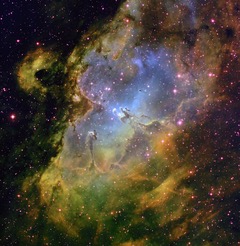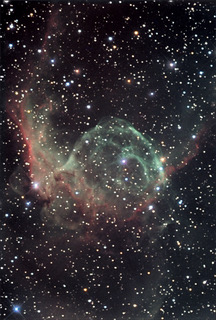|
Amazingly, even with 100 billion galaxies, each averaging 300 billion stars, our observable universe is almost completely empty.
These two facts should clarify the emptiness of space.
1)
Imagine a giant balloon surrounding our Sun that expands until it
reaches the nearest neighboring stars. That balloon would be big enough
to contain every star in our observable universe, and then
some. But, it actually contains only 1 star. Most of the universe is the
space between galaxies, which is even emptier.
2)
Everything we see — stars, oceans, mountains, even lead bricks — is
almost entirely empty space. All we see is made of atoms comprised of
protons, neutrons, and electrons.
Physicists
believe electrons have zero size. Protons and neutrons are also
probably almost entirely empty space, but just for fun, let’s say they
are solid balls with radii of about 1 trillionth of a millimeter.
We
know the radius of our observable universe is about 45 billion
light-years, and that it contains 10^80 (1 followed by 80 zeros) protons
and neutrons. So, even if protons and neutrons were solid, our universe
would be:
99.999,999,999,999,999,999,999,999,999,999,999,999,999,999,93% empty. To save you from counting, this number has 45 nines.
Anything other than empty space is very special indeed.
 One might ask: Why is there so little stuff? But, the really interesting question is: Why is there anything at all? One might ask: Why is there so little stuff? But, the really interesting question is: Why is there anything at all?
When
our universe began in a Big Bang, energy was converted into exactly
equal amounts of matter and antimatter. If this equality had continued,
every particle of antimatter would have annihilated with a corresponding
particle of matter, taking both into oblivion, and leaving only light.
Our universe would have been entirely empty.
Our existence depends on a tiny, inexplicable asymmetry in one of the four forces of nature: CP-violation in the weak force.
Symmetries
are powerful simplifying principles that physicists love. Here, C
denotes the symmetry operation of replacing particles with their
corresponding antiparticles and vice-versa, and P denotes taking the
mirror image.
The
strong nuclear force, the electromagnetic force, and gravity all seem
perfectly symmetric under C alone, P alone, and the combined symmetry
CP. These three forces treat matter and antimatter exactly the same,
thus preserving their relative numbers. But, the weak force, an
iconoclast in many regards, is just a little bit different.
The weak force is completely antisymmetric under C, and under P.
For
example, nature produces left-handed neutrinos but never right-handed
neutrinos — a 100% P-violation. Nature also produces left-handed
neutrinos but never left-handed antineutrinos — a 100% C-violation. But
for every reaction that produces left-handed neutrinos, there is a
comparable reaction that produces right-handed antineutrinos.
Physicists
were distraught to discover nature violated C and P, but at least
nature was decisive — violating these symmetries 100% of the time. And
at least nature preserved CP-symmetry…or so we thought.
About 50 years ago, physicists discovered CP-violation in several decay modes of KL, the long-lived neutral kaon. One of those experiments was my Ph.D. thesis. [“Long-lived” is relative — the KL lifetime is 52 nanoseconds, 578 times longer than the short-lived neutral kaon.]
In KL decays, which involve the strange quark, CP-violation is a 0.3% effect. This is even more distressing than C and P-violation — why is nature 99.7% symmetric?
Theorists
showed this tiny effect must be indirect; it could only result if there
were as-yet-undiscovered particles mediating these processes. And over
the next 25 years, physicists discovered a complete third generation of fermions — the top quark, bottom quark, tauon, and tau neutrino.
In some decays of the bottom quark, CP-violation is as much as 70%. We now know CP-violation occurs both directly in the weak decay processes and indirectly in the mixing of quantum states before decays.
 While
50 years of research has improved our measurement precision from 10% to
1%, we still have no clue why CP-violation exists. But, we wouldn’t
exist without it. While
50 years of research has improved our measurement precision from 10% to
1%, we still have no clue why CP-violation exists. But, we wouldn’t
exist without it.
Without CP-violation, matter and antimatter would have completely annihilated one another, leaving only light.
CP-violation
enabled a slight shift in the matter/antimatter balance. In round
numbers, by the time the universe was 1 second old, for every 1 billion
particles of antimatter, there were 1 billion and 1
particles of matter. The billions annihilated one another, creating the
ubiquitous cosmic microwave background radiation (CMB), and leaving
only the 1 extra particle per billion of matter.
Everything we see is comprised of the 1-in-a-billion surviving particles of matter.
The
exact number is critical. If slightly more matter had survived, the
universe would have collapsed into a single black hole. If slightly less
matter had survived, the universe would have expanded too rapidly for
stars to develop. Only in an extremely narrow range would just enough
matter have survived to make our universe habitable.
We know precisely what the survival rate was, but have no idea why it has that specific value.
This remains one of our universe’s charming mysteries.

Best Regards,
Robert
October, 2019
Note: Previous newsletters can be found on my website.
|